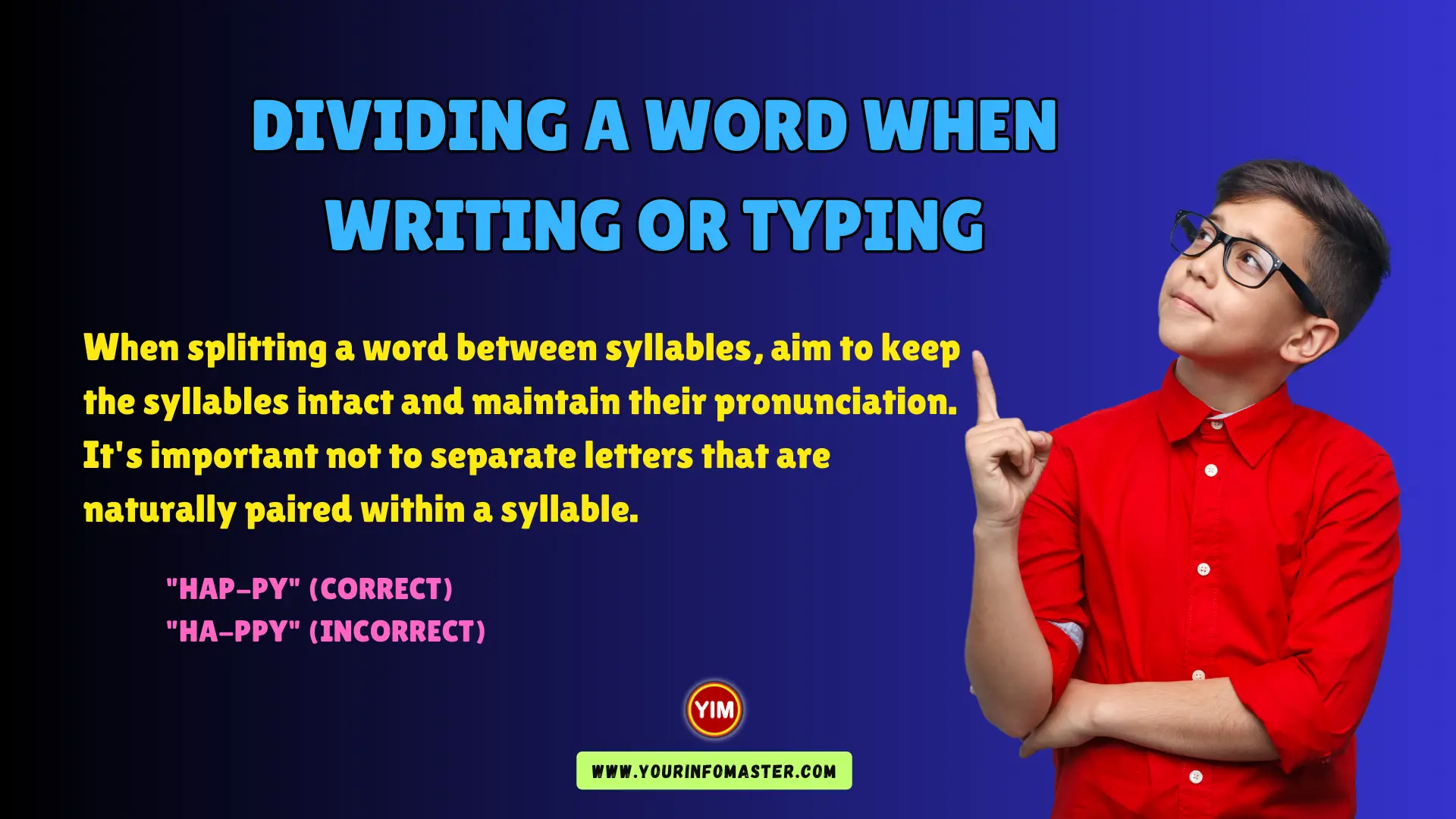In this article I will teach you about Dividing a Word When Writing or Typing.
In the realm of writing and typing, situations occasionally arise where words need to be split at the end of a line due to space constraints. While modern computer software often handles this seamlessly, the importance of understanding the rules for manual word division remains significant, especially when utilizing typewriters or penning thoughts on paper.
This article delves into the art of word division through hyphens, offering insight into the guidelines that facilitate precise and appropriate word splitting – a valuable skill for enhancing your written communication, particularly in cases where automated assistance isn’t available.
Also read: What are the Plant Names in Spanish?
Five Rules for Dividing Words
Dividing words at the end of lines involves adhering to certain rules to ensure that the split is both visually and linguistically appropriate. Here are three fundamental methods for dividing words:
1. Dividing by Syllable: When splitting a word between syllables, aim to keep the syllables intact and maintain their pronunciation. It’s important not to separate letters that are naturally paired within a syllable.
Example:
- “hap-py” (correct)
- “ha-ppy” (incorrect)
2. Dividing by Structure: Consider the word’s structure and meaning while deciding where to divide it. Avoid creating odd-looking fragments, and ensure that each portion can be easily recognized and understood.
Example:
- “un-happy” (correct)
- “unh-ap-py” (incorrect)
3. Dividing by Meaning: Divide words in a way that respects their meaning and avoids altering the interpretation. Make sure that the divided parts do not create confusion or alter the original word’s sense.
Example:
- “re-form” (correct)
- “re-f-orm” (incorrect)
4. Dividing Compound Words: When dealing with compound words, try to divide them at natural points where they retain their meaning. If possible, avoid splitting the components of the compound word.
Example:
- “base-ball” (correct)
- “ba-se-ball” (incorrect)
5. Dividing Prefixes and Suffixes: Incorporate prefixes and suffixes into your word division with care. Keep the prefixes or suffixes intact, even if the main part of the word needs to be divided.
Example:
- “pre-fix” (correct)
- “pr-e-fix” (incorrect)
Understanding these rules and practicing them will enable you to divide words effectively, maintaining readability and coherence in your writing. Remember, the goal is to create a seamless division that doesn’t interrupt the flow of the text or confuse the reader.
Also read: What are the Animals Names in Spanish?
Additional Rules for Dividing Words
Here are the six additional rules to guide you on when and how to divide words:
- Never Divide Within a Syllable: Avoid splitting a word in a way that separates its syllables, as this can disrupt pronunciation and comprehension.
- Avoid Dividing Two-Syllable Endings: Refrain from dividing words that end with two syllables, like -able or -fully, as doing so might create confusion.
- Exercise Caution with Two-Letter Endings: Generally, avoid dividing a word if one of the parts ends with just two letters like -ed, -er, or -ic. However, an exception exists for -ly.
- Avoid Single-Letter Divisions: Prevent division in cases where one of the parts would become a single letter, as this can lead to ambiguity and hinder understanding.
- Keep One-Syllable Words Intact: Do not divide words that consist of only one syllable, as these are typically short enough to remain undivided.
- Skip Dividing Short Words: Avoid dividing words with fewer than five letters, as these small words can often remain whole without disrupting readability.
Conclusion
Mastering the art of dividing words when writing or typing is a valuable skill that enhances the readability and aesthetics of your content. By adhering to the rules and techniques discussed in this article, you can effectively handle word divisions, ensuring that your text appears polished and professional, whether it’s handwritten, typed, or produced using digital tools.
If you really enjoyed the article “Dividing a Word When Writing or Typing,” then I would be very grateful if you’d help it spread by emailing it to your friends or sharing it on Twitter, Instagram, or Facebook. Thank you!
Have you read “Dividing a Word When Writing or Typing?“ Which of these blogs are you reading, and how is it similar to one of them?
Read More
- Basics of Sentence Structures in English
- Basics of Sentence Type for English Learners
- How Do You Writing Descriptive Paragraphs?
- 5 Tips to Improve Writing in English
- 10 Common Sentence Mistakes in English
- Common Spelling Problems in English
- Showing Addition in Written English
- Synonyms for Words that start with E
- Synonyms for Words that start with D
- Synonyms for Words that start with C
- Synonyms for Words that start with B
- 30 Spanish Sayings With English Translations
- 50 Quotes on Love in Spanish that will Melt Your Heart
- 50 Most Famous Spanish Quotes
- 20 Most Famous Spanish Proverbs
- 10 Facts About the Spanish Language
- Synonyms for Words that start with A







